#Christmas: History and traditions of the holiday 2021
Text
Celebrating Christmas in the Philippines: The Christmas Capital of Asia (Part 1)
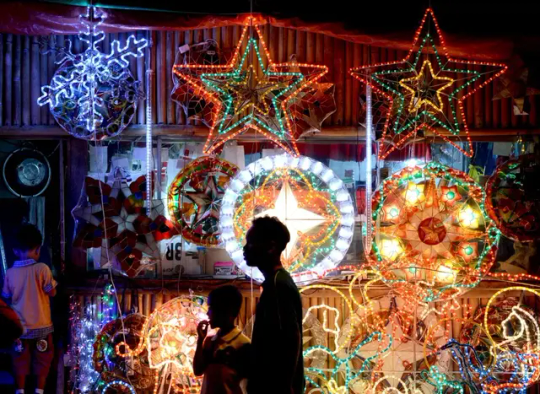
A store in the Philippines that sells Filipino Christmas decorations sourced AFP Photo/Noel Celis, posted by Ana Catalina Paje (2021) via Yahoo! News
Filipino Christmas is notorious worldwide for being some of the longest celebrations of the holiday in the world. Often said to start on the month of September and ending at around February, being the main event for almost half the year is nothing to sneeze at. Even with this, how much do you know about Filipino Christmas exactly?
Just like all Christmas traditions from all around the world, the Filipino way is rooted in long tradition and history that stems from colonial, and postcolonial practices that continue to evolve into the present day with many more additions in the future.
Before I start
As usual, it is important for me to recognize that the Philippines is a diverse country with different cultures, traditions, and histories with each community having their own unique practices and experiences with the holidays. There is no way for me to fully encompass every single experience that every Filipino has for this holiday as well as the experiences of those who don't even celebrate the holiday. This is besides the fact that uncovering sources for more specific traditions or practices may be either difficult or impossible for me to access easily.
I also want to note that not all Filipinos celebrate Christmas such as Filipinos of different religious backgrounds such as Muslim, Hindu, Buddhist Filipinos, or of different denominations that may not celebrate Christmas such as members of some Protestant denominations.
I also had to split up this post into two parts because Tumblr wouldn't let me make extremely long posts. Part 2 is linked here.
With that being said, feel free to add your own stories and experiences to this post if you have any to share or even information that I may not had discussed at all.
(This was supposed to go live on the 25th but it got delays because of personal stuff sowwyyyy. I'll just reblog this for next year too lol)
Etymology
In the Philippines, Christmas is primarily called pasko with the season itself called kapaskuhan . It comes from the Spanish word pascua, from the phrase pascua de navidad. Pascua comes from the Latin pascha which then comes from the Greek πάσχα (páskha) which then came from Hebrew's פסח (pesach) originally referred specifically to Passover (Vivas, 2021).
From pascua and, by extension, pasko's usage to refer to Easter (i.e. pascua de resurrección and pasko ng pagkabuhay respectively), the word was then later used to refer to Christmas (i.e. pascua de navidad) as the word often referred to the celebratory aspect of the holiday. The Spanish brought over the dual usage of the term for both holidays during the colonial period.
Certain variations of the word around the country typically follow the same root with pasku or pascu being used in Kapampangan, a closely related language to Tagalog, and some other languages keeping the usage of pascua like the Spanish creole language of Chavacano.
Filipinos today often interchange the usage of pasko and Christmas when discussing the holiday, and sometimes may use an informal Filipinized spelling of Christmas as krismas by spelling the English word by sound (a trait of a lot of Filipino languages) which mimics a Filipino accent but I honestly had not seen this in a while.
History
Surprisingly,according to legend, the story of Christmas in the Philippines doesn't start on 1521, the year Ferdinand Magellan landed on the island of Cebu, nor the subsequent years after that, but on 1324, nearly 200 years before the Spanish came anywhere close to the Philippines islands.
In an old church called Saint James the Great Parish Church found in Bolinao, Pangasinan, exists a marker that makes the interesting claim that the first mass, and by extension the first mass in the history of the Philippines took place in the very place where the church now stood as a thanksgiving mass for their safe landing on the island (Sotelo, 2015). Ocampo (2012) states that there had been claims within Pangasinan folk legends that this first mass was also specifically the first Christmas mass that had taken place in the history of the Philippines which had embedded itself on the town of Bolinao's folklore.

A photo of the plaque found in St. James the Great Parish, Bolinao, Pangasinan showing Fr. Odorico posted by Vera Bajado (2021) via TripAdvisor
The story goes that on a stormy night, during his missionary travels to Asia, Italian Franciscan friar and missionary Blessed Fr. Odorico of Pordenone landed on the islands to take refuge in the town to wait for the rains to pass. It is said that they had met "hostile natives" who later changed their disposition after he proved himself harmless. He later celebrated the mass with his crew and the locals, people attributing these events to have taken place on the 25th of December (Yuvallos, n.d.). The full text for the marker that relays this story was transcribed by the blog Vagabonding with Chu (2017) and reads:
"Blessed Odorico
From Friuli (Italy)
Franciscan Missionary
Born in Pordenone (Italy) around 1275 A.D. – Father Odorico, a courageous and religious Franciscan missionary pioneered the spread of the Gospel in Asia and China. He traveled always barefooted among indescribable difficulties and dangers exhausting his energies in the service of the Kingdom of God.
In 1324, after landing and taking refuge in Bolinao, Pangasinan during a stormy weather, Father Odorico celebrated a thanksgiving Mass in honor of their safe journey and his mission. He also indocrinated and baptized many of the Malay immigrants in Bolinao. He returned home to Udine (Friuli) Italy after thirteen years mission. He died a holy death on January 14, 1331. His precious remains are kept in an artistic tomb of the parish church of our Lady of Mount Carmel, in Udine (Italy).
Blessed Odorico, Pray for Us."
- Marker in front of St. James the Great Parish Church
This claim is contested by historians including Ocampo (2012) who even adds that the additional parts of the story makes it much more unbelievable such as the claim that Fr. Odorico also planted the first Christmas tree which had not been a popular Christmas staple until the 19th Century. The National Historical Commission of the Philippines later affirms that the first mass did not in fact take place on Bolinao, Pangasinan but on Limasawa, Southern Leyte on Easter Sunday 1521 (Yumol, 2020).
The first Christmas mass most likely happened either a little after this time with a celebration possibly taking place during the stay of Miguel Lopez de Legaspi when arrived in the Philippines in an effort to start colonizing the islands. He was able to establish a Spanish settlement called the Villa del Santisimo Nombre de Jesús where he and his men lived in from 1565 - 1569 where celebrations for Christmas definitely must have taken place. The last of the Spanish forces in the country had also, incidentally, left from Cebu on Christmas day 1898 (The Freeman, 2021).

An old map of Villa del Santisimo Nombre de Jesús, now modern day Cebu posted by the Basilica Minore del Sto. Niño de Cebu (2017).
A lot of older traditions persist to the present day but the more modern-looking Christmas, much like in other Western Christian countries didn't become as popular until the late 19th to early 20th Century coming mostly from other European and American influences.
Traditions such as the Christmas tree had not existed in Filipino Christmas celebrations until the late 19th century, with the first seen mentions of it in the writings of Dr. José Rizal both in his translation of Hans Christian Andersen's work as well as a letter he had wrote home from Berlin to his sister Saturnina, who was called Neneng, and her husband Manuel, who was called Maneng, where he translates a story about a sad pine tree with the words"Ang Puno ng Pino" (en. The Pine Tree) next to two drawings of Christmas trees, Ocampo (2012) writes.
Ocampo continues to explain how Rizal wrote about the many German traditions that he had encountered in Berlin, including the decorating of a pine tree for Christmas. Ocampo later transcribes this letter in his article:
"There are some beautiful and good [German] customs, like Christmas, which gives me pleasure to describe here for it is not found in Spain and you have not read about it in Spanish books. On Christmas Eve they bring from the forest a pine tree, and this tree is chosen because, besides being erect, it is the only tree that keeps its leaves during winter—I say it badly; not really leaves, but a kind of needle. It is decorated with tinsel, paper, lights, dolls, candy, fruits, dainties, etc., and at night time, it is shown to the children (who should see the preparation of it), and around this tree the family celebrates Christmas."
- Dr. José Rizal in a letter to his sister Saturnina Rizal and her husband Manuel Hidalgo (Ocampo, 2012)
The Christmas tree, however, didn't become fashionable for the wider public's own Christmas celebrations until the arrival of the Americans, of which brought their own American traditions to the Philippines.
Ocampo continues to write that Rizal compared the customs of Germans and the Spanish and said that the Spanish holiday gets ruined because of too much praying. Rizal states that the Germans and those of Northern Europe, celebrate with the idea of preserving some level of childhood innocence and allow children to play unlike the Spanish which he describes as a much more crass culture who don't allow much play for the season and instead make these children pray during the holiday. Ocampo continues to transcribe:
"... the Spaniards do not indulge in poems for children and young people, or as the vulgar expression goes, they do not beat around the bush. They attend more to the positive, or the stomach. And Carambas! they would say; let us amuse ourselves and let children and young people seek their own amusement as best they can. They do seek their own diversion, with the result that the children and young people in Spain lack the charming innocence and candor of those in the North [of Europe], without malice, without great preoccupations (...) This is because here [in Germany] they know how to give age its due, unlike in other countries where children are not allowed to be themselves, to make noise or to play. Instead, they are made to recite the rosary and novena until the poor youngsters become very sleepy and understand nothing of what is going on (...)"
- Dr. José Rizal comparing German and Spanish Christmas customs in his letter to his sister Saturnina and her husband Manuel (Ocampo, 2012).
This aligns with the shift in most Western Christian societies from viewing children (mostly white children) as sinful or ignorant smaller adults to a more romanticized ideal of innocence, allowing children more time for play with less responsibilities that wasn't afforded to them in the previous centuries. The romanticized view of childhood shifted the focus of Christmas on prayer and generosity to be more family, and more specifically, child-centered (Cecire, 2020). This was especially true for more industrialized countries of the time including late 19th Century Germany, of which Rizal was living in during the time he sent that letter to his sister and brother-in-law.

Photograph of the "exhibition of Christmas trees"; at Maryknoll Normal College which features students from the 1930s showing off their Christmas trees that they had created during an art class with Sr. Caritas in the center and art teacher Miss Cristobal at the left-side of the photo at the back. The image was sourced from the University of Southern California Libraries' International Mission Photography Archive, ca.1860-ca.1960, Maryknoll Mission Archives posted by John Tewell (2016) via Flickr.
Filipino Christmas continued to be influenced by non-Hispanic Western Christian countries with the turn of the century and the start of the American colonial era. Traditions like greeting cards which the Americans introduced popularized the figure of Santa Claus and white snow as strong associations with the holiday despite the Philippines never experiencing any snow in its entire history (Roa, 2017).
After the American occupation, Filipino Christmas continued to develop into the modern day adding new traditions stemming from older ones, continuing to change and grow even today.
(Part 2: Practices in the Present Day)
(Reference List)
#mayaposts#mayapino#filipino#philippines#filipino culture#christmas#filipino christmas#history#filipino history#christianity#christian history#traditions#christmas traditions#filipino christmas traditions#colonial history#spanish colonial history#american colonial history#long post
11 notes
·
View notes
Photo
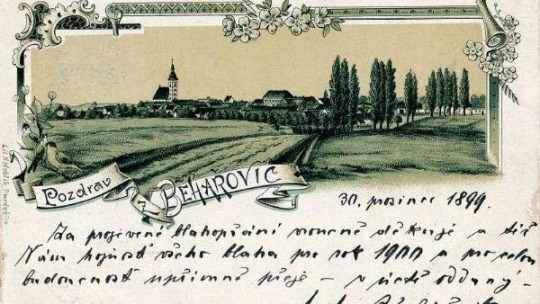

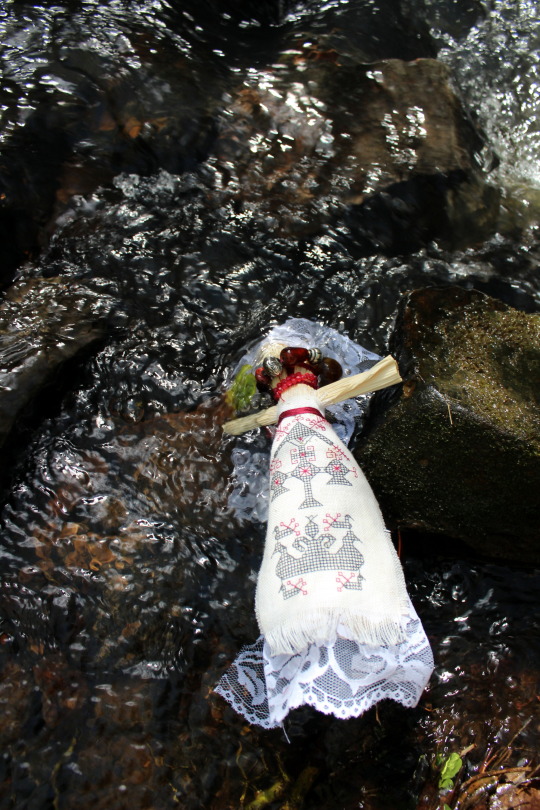






Czech Calendar Customs Master Post
I’m an American who has always been fascinated with family history. The most recent arrivals in my family from the old world were my Great-Grandparents who emigrated from Běhařovice, a small village in Southern Moravia, Perhaps it is because they are my most recent connection to Europe that I’m pulled so strongly toward their traditions. In this post I’ll provide links to my posts documenting my attempts to integrate Czech calendar customs into my practice, as well as other resources. In 2023 I plan on doing more detailed articles and will add them to this article. I am in no way an expert on the customs of Czechia, just a descendant attempting to connect with my ancestors.
From Groundhog Day to the Three Kings: Customs and Traditions of Villages in Znojmo (Southern Moravian district in Czechia that my great-grandparents were from) Machine translated by google
February/March/April 2023 Devotional Schedule
Hromnice
Hromnice is the holiday that takes place at Candlemas/Groundhog Day/Brigid’s Day (February 2nd)
Bearers of Folklore: One More Hour on Hromnice
Background
My 2022 Hromnice candle
2023 Hromnice candle
Blessing my Hromnice candle
Waking Up Perun
Drowning Morana/Smrtka (Around Vernal Equinox)
Background
Drowning Morana 2023
Drowning Morana 2022
Drowning Morana 2021
Drowning Morana 2020
Drowning Smrtka in my Great-Grandparent’s Village
Morana embroidery
Masopust (Carnival)
Background
Fat Thursday Dinner 2022
Kupala Night (Midsummer)
Midsummer 2022
Dozinky (Autumn Equinox)
Background
2022 Dozinky wreathe 1
2022 Dozinky wreath 2
Dušičky (All Soul’s Day)
Dusicky 2022
Koleda (Winter Solstice)
Background
St. Thomas’ Day
Koleda dinner 2022
Christmas and Advent
My St. Andrew’s Eve 2022 (November 30)
St. Andrew’s Eve (November 30)
My St. Barbara’s Day (December 4)
St. Barbara’s Day (December 4)
St. Nicholas’ Eve (December 5)
St. Ambrose Day (December 7)
Feast of the Immaculate Conception (December 8)
St. Lucy’s Day (December 13)
Christmas Eve Dinner Plans for 2022
Christmas Eve Dinner 2022/2023?
St. Stephen’s Day (December 26)
Vanilla crescents/ Vanilkové rohlíčky recipe
Walnut boat fortune telling 2022
Apple fortune telling 2022
Free paper cut out ethnographic nativity scene by painter Maria Fischerová-Kvěchová
My version of the cut out ethnographic nativity scene
Czech and Moravian Christmas Carols
2022 Czech inspired Christmas embroidery
Foods for the New Year
New Year’s Sweepers
New Year’s Lunch
Feast of the Three Kings
98 notes
·
View notes
Text
Playwright James Ijames on 'Fat Ham,' the spotlight on Black queerness and life after a Pulitzer
A Q&A with the Pulitzer Prize–winning playwright of 'Fat Ham.'
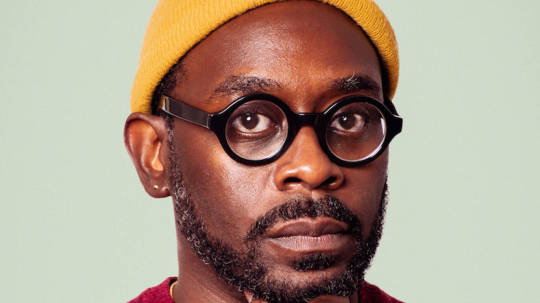
Written by Marcus Scott
Wednesday February 8 2023
James Ijames won the 2022 Pulitzer Prize for Drama for Fat Ham, an irreverent riff on William Shakespeare’s Hamlet that feels like a call to arms for Black joy and queer representation. A jambalaya of satire, magical realism and the American domestic sitcom, the play follows Juicy (Marcel Spears), a morose online-college student, as he tries to come to terms with the marriage of his newly-widowed mother, Tedra (Nikki Crawford), to his Machiavellian uncle Rev (Billy Eugene Jones). “This ain’t Shakespeare,” Ijames noted in the show’s program. “Don’t get me wrong. I love Shakespeare, this just ain’t him. This ain’t a tragedy…This play is offering tenderness next to softness as a practice of living. This play is celebrating Blackness that is traditional and weird and lonely and happy and grieving and honest and frightened and brave and sexy and churchified and liberated and poetic.”
Fat Ham had its world premiere in the spring of 2021 in a digital production by Philadelphia’s Wilma Theater. A year later, it made its onstage debut at the Public Theater, directed by Saheem Ali, and became one of the buzziest plays of the season. On March 21, 2023, that production will begin a limited run at Broadway’s American Airlines Theatre. We chatted over FaceTime with the playwright as he prepared to step into rehearsals.
Fat Ham moves Hamlet from a medieval Danish castle to a modern-day cookout in North Carolina. Why a barbecue?
“Barbecues are cumulative spaces. It starts with a few people and then it grows. There’s food, and people are drinking. It’s a space of truth-telling, it’s a space of game-playing, it’s a space of intimacy and warmth—and it’s where secrets come out. My family recently came together for the Christmas holiday and a cousin of mine made an announcement about being pregnant. Everyone was just so excited and lifted by that; everyone’s energy turned towards them in this really beautiful way. I wanted a space where that sort of collective joy was possible and also where a big, messy argument was possible. Where a fight was possible, where drinking was possible, where eating was possible, where romance was possible. In Shakespearean comedies, when you go outside or into the woods—like the forest of Arden [in As You Like It] or the forest in Midsummer—it’s a space where anything’s possible. There’s magic. We’re not inside, in a cold room in a cold castle. We’re outside: We have decorations, we’re colorfully dressed. We are in the sort of space where magic is palpable and possible.”
Juicy is not your typical Hamlet. He is Black and Southern and, as you describe him in the play, “thicc.” What was the motivation behind that?
“Well, I’m Black and from the South, and that drove my desire to play with people that sound and look like me. When you see productions of Hamlet, he's usually white and sort of athletic. I wanted to make a version of this play that was open to a body type that wasn't that; I'm a person who, for pretty much my whole life, has had some struggle with my weight and my perception of what I look like and how I feel in my body. And another thing I wanted to do was to explore Blackness in the South in a way that felt contemporary, that didn't feel held by history—looking at Southern communities right now as opposed to a nostalgic imagination of the Black South.”
Why did you choose for Juicy to have a passion to study Human Resources in college?
“Human Resources is about care and workflow. Efficiency. I wanted Juicy to have a passion for something that felt antithetical to his father. He wants to make sure people are okay.”
How does that contrast reflect other things about the way you have approached Shakespeare’s story?
“I think the play is exploring multiple modalities of masculinity. We see a lot of different kinds of Black masculinity on the stage. We see Juicy, we see Tio, we see Larry, we see Pap and Rev. And there’s a masculinity that’s implied about the community that they live in, that is sort of present in the room. I wanted to show that masculinity is not monolithic—it’s not as simple or cut-and-dried as it’s often depicted. I also wanted to explore cycles of trauma and violence in families. I’m interested in primordial stories, stories that no matter what culture you walk into, there’s like a version of them. I always think of Hamlet as—and I don't know that a lot of people think of it this way—but I think of Hamlet as a Cain and Abel story: the story of a sibling killing their sibling to get ahead. Anybody can relate to that; that’s a [narrative] that you inherit and moves with you through generations. And the younger folks in the play have to make some decisions about whether or not they want to continue that, whether that’s what they want their lives to look like and their relationships to each other to look like. I’m calling into question the stories that we’ve been passed down as wisdom. Because sometimes it’s wisdom, but more and more I look at those stories as cautionary tales of what you shouldn’t do. Vengeance isn’t gonna help Juicy. Killing his uncle is not gonna help Juicy’s life get any better.”
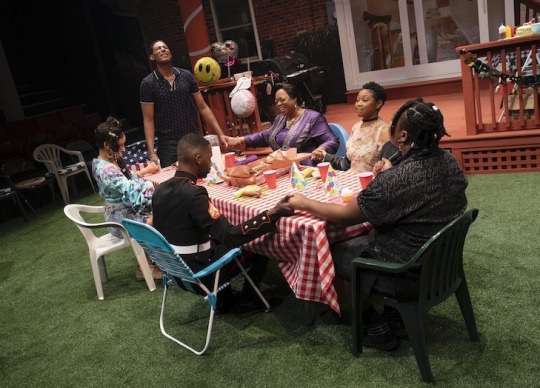
Your breakthrough play was Kill Move Paradise in 2017. How do you think you've changed as a writer since then?
“Oh, gosh. When I look at Kill Move Paradise, that play is quite erratic, you know [he laughs]. I always describe it as the way that I try to metabolize my anger and my fear and anxiety about being a Black body driving around in America, walking around in America, just trying to live my life. And so it has that anxiety in it. It has that fear and nervousness in it. It’s in the text, you can feel it on the page. As I've gotten a little older, I've experienced more and I've written more—the more you write, the better writer you become. I'm more intentional with story, with plot; how I'm weaving a theme or a theory into the action of a play is a bit more sophisticated than it was when I was starting out. The anger is usually shrouded in rebellion or exuberance. At a point in my life, anger sort of dragged me down into a space of high-blood-pressure fury. But I think now the work offers people an invitation to metabolize anger in a different way. By the time we get to the end of Fat Ham, people are dancing in the aisle.”
They certainly are.
“And that is not to negate the fact that we’ve just watched the thing that had pain in it, that had trauma in it, that had violence in it. But just because you’ve been through difficulty doesn’t consign you for the rest of your life to difficulty, to trauma, to pain. We have access to joy, we have access to resilience, we have access to exuberant ecstasy. Black history, in this country in particular, teaches us that: The blues and jazz and hip-hop come out of extraordinary awful scenarios and settings. Those art forms are undeniably both Black, but undeniably exuberant, resilient, unabashed, queer—all of those things! They possess all of those things. When I sit down to write a play, I know that at the end I have to send people out into the world, into the streets, into workplaces, into homes. My hope is that I’m leading them to some hope.”
This play is pretty fantastical, and there are various displays of spectacle and magic. There are also a panoply of images and homages to the Pan-African cultural experience—allusions to Louisiana Voodoo as well as Central African, Creole and Haitian Hoodoo symbology.
“Ghosts are a feature in a lot of my plays. Magic is a feature in a lot of my plays. Because I’m a person who grew up with people who kind of had magical ways of thinking. I grew up Baptist: hardcore, every Sunday, sang in the choir, youth ministry, youth usher—like, I am a church gay! I also grew up in a family that has New Year’s Eve traditions that they do, and will throw salt over their shoulder, or say “Don’t sweep over a single man’s shoe because he won’t get married.” That sort of Hoodoo connection to the spirit world and connection to ancestors was also a big part of the family that I grew up in. And so magic in that respect feels very real to me. Ancestors feel very present—the reverence for people who have passed on is immense. So, to me, the ghost of Juicy’s father showing up isn’t just a specter from this other world that is coming with caution and with information. Juicy is having a conversation with his ancestor and he talks to his ancestor, the way that I talk to mine. The thinness of that veil between here and there—I relish in that, and the theatrical allows you to do that with a lot of ease. I didn’t want the ghost to be a joke. He’s funny—that cat is extremely funny—but he also has these great moments of, like, “Wow, I really messed you up.”

There is a long literary tradition of Black writers explaining Blackness to people who aren’t Black. You don’t do that here. In fact, this play comments on performing Blackness, trauma porn and “enterpainment” on stage—and it’s done with humor. Why was this important to you?
“Humor is powerful. It opens us up to hearing things in a new way. It’s a big part of all of my plays. The question about explaining Blackness is huge to me. I don’t feel like I have to explain Blackness to an audience. I’m assuming that everyone will catch up who doesn’t understand.”
At the end of the show, there’s a cover of the funky dance-pop disco tune “Kill The Lights” sung by Broadway actor Mykal Kilgore. What inspired that particular needle drop?
“I love disco music, just personally. Anybody can dance to it. If you are off-rhythm, you will be on a rhythm with disco music because it’s four-on-the-floor and is just all-encompassing. It strives for ecstasy, it strives for moving from a passage from one state to another. Probably because they were all like using drugs and having sex while they were listening to it in the Seventies and Eighties. But this is a contemporary artist singing in the disco style. It’s not a song from the era. It just moves people! That music moves people.”
If you were to classify your previous plays by genre, with Fat Ham being disco, what would your other shows be?
“Ooh.” [He laughs.] “I think Kill Move Paradise, if I had to put a genre to it, it’s Southern hip-hop, right? It’s sort of grounded in that culture. I would say White is like pop music—it’s like my Ariana Grande album. And Miz Martha is Americana music. It’s like bluegrass with a trap beat.”
Only nine writers of Black descent have been awarded the Pulitzer Prize for Drama in its 105-year history: Charles Gordone for No Place to Be Somebody, Charles Fuller for A Soldier’s Play, August Wilson for Fences and The Piano Lesson, Suzan-Lori Parks for Topdog/Underdog, Lynn Nottage for Ruined and Sweat, and the last four prizes in a row—Jackie Sibblies Drury for Fairview in 2019, Michael R. Jackson for A Strange Loop in 2020, Katori Hall for The Hot Wing King in 2021 and now you. Is something going on in the zeitgeist? Is there something special about Black writers that make their work more urgent right now?
“I think a few things are happening. Black writers and Black directors have been trying to push the form in new directions, to be both in conversation with the cannon and also pushing against the cannon. Those four plays—starting with Fairview and going to A Strange Loop, The Hot Wing King and Fat Ham—all four of those plays are actively doing those things. And so are some plays that haven’t won Pulitzers but have been defining culturally, like Slave Play and things like KPOP. The audience for that work is already there and primed, and it’s just waiting for someone to make art for them, you know what I'm saying? People are curious about what is possible in the form. I remember seeing Fairview and just being blown away by the audacity of it. It made me want to be more ambitious—to create more of a social experiment with my work in collaboration with an audience. I think the same thing is true of A Strange Loop and Hot Wing King in terms of those plays’ exploration of Black queer identity. And that flows rather beautifully into Fat Ham, which is doing the same sort of thing by taking a play that people cherish like Hamlet and saying, ’Not only is this mine, it’s mine in these particular ways, and this is what I’m gonna keep and this is what I’m gonna discard.’ So some of it is just us, as writers, wanting the form to feel as vital and as urgent as possible. And one way to do that is to examine how we write things and try to find new ways into storytelling.”
Those last three plays in particular have centered on Black queerness, and on what we might call radical softness. Is there something in the ether? Was there something in the culture that made us say, “Now that’s something we need to address, to attack, to appraise?” Because it all kind of happened around the same time.
“Hmm. I don’t know. That stretch of plays spanned the heartiest points of the pandemic, and we were all quite hungry for connection, closeness, touch, tenderness. And that offered an opportunity for people to be excited about seeing something that felt soft or vulnerable. I think people respond to that because we want to be better. Culturally, I think, we want to try to do things differently. It remains to be seen whether or not that will continue, but people wanted to engage with things that felt tender, that felt connective, and all of those plays are great examples of that. And I think that’s also true of Fairview; with the separation that it is asking for, it’s asking for people to sit in an embodied space with an idea.”
Last question: How has your life changed post-Pulitzer? Has that changed how people think of you and your work? Or how you think of yourself and your work?
“Oh my gosh! It’s just made my life so much busier, but it’s also made me focus on the work. Refocus on my craft and my practice. I don’t want this prize to freeze me in time. I want to keep pushing and keep expanding what I do.”
Fat Ham begins previews at the American Airlines Theatre on March 21, 2023, and opens on April 12. Tickets are available here. This interview has been condensed and edited for clarity.
Follow Marcus Scott on Instagram:@therealmarcusscott
Marcus Scott

#Marcus Scott#MarcusScott#WriteMarcus#Write Marcus#playwriting#playwrights#playwright#James Ijames#JamesIjames#Fat Ham#FatHam#Broadway#The Public Theater#Public Theater#Time Out#TIme Out New York#TimeOutNewYork#TimeOutNY#Time Out NY
6 notes
·
View notes
Text

Have we decided what the problem with Thanksgiving is going to be this year?
We could start with the base-level perennials — the godawful travel, the risk to one’s diet, the cousin who is loudly certain that someone has slipped gluten into the gluten-free stuffing. There’s typically a grievance against the potatoes: the format, mashed or casserole, whether or not to marshmallow, why is there never enough. Someone has canceled at the last minute; someone nobody invited shows up anyway. At least one child refuses to sit at the kiddie table, the teenagers refuse to put their phones down at whichever table, an uncle insists on watching the football game at the table. The table itself looks nothing like tables on Instagram.
But in recent years, we’ve had particular reason to squabble over the holiday.
For four unforgiving years, from 2016 to 2020, the problem was breaking bread with your political nemeses. Advice columns bristled with agita. How do you handle your Trump-loving father-in-law or the out-of-towners who show up in MAGA gear? “No baseball caps at the table” was USA Today’s Rule No. 7 for avoiding political food fights in 2019. In some other neck of the woods, aggrieved citizens despaired about their Occupy nephew storming in unshaven from his sophomore year at some college “back East.”
No sooner was Trump voted out than we had a new thing — the threat of death — to antagonize the proceedings. With the government urging Americans to stay home, Thanksgiving 2020 was a potential superspreader event extraordinaire — and one reserved exclusively for family members. Were you inviting that great-aunt because you enjoyed her company or because you wanted her dead? Into 2021, the challenge persisted as the vaccinated squared off against the anti-vaxxers, with divided families worried about the full immunological spectrum of their extended entourage.
Also last year and just in time for its 400th anniversary — though one could hardly suggest the issue was new — some raised the pesky question of Thanksgiving’s celebration of genocide. This forced people intent on their pumpkin pie to confront the fact that Thanksgiving is, at root, a commemoration of conquest and subjugation. It is, after all, a day that the United American Indians of New England observe as a day of mourning. The original Native American “helpers,” the Wampanoags, have expressed regret for helping the Pilgrims out in the first place.
Or maybe it all just makes you angry and resentful! What has happened to your cherished American tradition, you wonder? Must everything be problematic?
Nearly every holiday — with the possible exception of April Fools’ Day, but just you wait — has become some kind of political football. The Republican right has been catastrophizing about an alleged war on Christmas for over a decade, though nobody has alerted the pharmacy chains whose aisles are already laden with red-and-green candy. Meanwhile, one poorly chosen wig on Halloween, fraught with potential cultural offenses, can result in social disaster. Please, let it not be your kid who winds up the wrong kind of Disney character! Also in autumn, Diwali, a major occasion for Indians at home and abroad, has lately become a huge celebration across America. But who, some wonder, is allowed to put on a sari?
Ye olden holidays, they are a-changin’. For the past two years, President Biden has issued a proclamation naming the second Monday in October, also known as Columbus Day, Indigenous Peoples Day in order to “celebrate indigenous history and our new beginning together, honoring Native Americans for shaping the contours of this country since time immemorial.” The obvious question there is, what took so long?
So let’s consider the nominees for this year’s chief Thanksgiving gripe: We could make a big deal out of the turkey shortage, for example. Both bird and side dishes have gotten notably more expensive, and with an impending recession, now really isn’t the time. After a summer of exorbitant and overbooked flights that got canceled just as its passengers straggled out of security, travel this year looks to be particularly crowded and unpleasant. And there’s always contagion to fall back upon. With Covid, R.S.V. and the flu all going around, a full-fledged gathering should provide ample opportunity to spread ill health.
But would it be a problem to suggest that maybe Thanksgiving not be a problem this year?
Boiled down to its essentials, Thanksgiving is a holiday about shared gratitude. We could just think about the “thanks” in Thanksgiving for a change. That gratitude may have originally been intended toward God and those Native Americans who helped the newly arrived colonists survive — and for whom atonement may have been more appropriate. But even for us secular humanists, Thanksgiving offers a moment to appreciate whatever good this year wrought, even if by accident or chance.
I can think of a few things to feel thankful for. As vexing as this country can be, the midterms ended with a semblance of democracy still intact. The Democrats retained the Senate, striking a necessary blow against insanity. And while Sarah Huckabee Sanders was somehow considered a suitable person to run an entire state, Wes Moore, the accomplished author of five books and a promising leader, was elected to lead another. Elon Musk has sent Twitter twisting and shrieking toward the hellish oblivion where it belongs. Every year, more people seem to recognize the wisdom of spatchcocking their turkeys. And the Little Pie Company, whose sour cream apple walnut pie I’ve been worshiping since high school, now ships nationwide. If nothing else, for many Americans, it’s a four-day weekend. I’ll spend mine grateful for any leftovers.
#settlers#colonializing murder and genocide#Native Americans Matter#Is There a Problem With Thanksgiving?#unthankful for your lies and genocide#more white lies#white hate#white historical forgetfulness
1 note
·
View note
Text
2021 Events
Feb 22-28 : historical-hetalia-week | found here
BC - 500 | Tradition
500 - 1000 | Tears
1000 - 1500 | Ink
1500 - 1800 | Opulence
1800 - 1945 | Novelty
1945 - Today | Memento
Free
Mar 20 : hetalia-writers-monthly | found here | overall theme "spring"
Sunshine | Colors
Hope
No matter how long the winter, spring is sure to follow - Unknown
Apr 16-Dec 7 : hwsrazzledazzle 's historic hetalia anthology | found here
May 20 : hetalia-writers-monthly | found here | overall theme "pride month"
Rainbow
Discovery | Love
“Don’t ever be afraid to show your true colours.”
May 30-Jun 5 : ruspruweek (deleted) | found here
Cold | Photos | Rest
Admire | Forgive | Uniform
Bandage | Candlelight | Touch
Free
Choke | First | Join
Smitten | Sweet | Warm
Beg | Hurry | Secret
Jun 14-20 : hwsrarepairweek2022 | found here
Language
Royalty
Culture
Historical
Soulmates | Free
Traditional outfit
Sunrise & sunset
Jul 4-10 : usukweek | found here
Rumors | History
Nostalgia | Nyo
Domestic | Fluff | Soulmates
Dreams | Fantasy | Magic
Tragedy | Pirates | Cowboys
Destiny/Fate | Cardverse
Free
Jul 18-24 : hwsmicronationweek | found here
Nyotalia
Siblings
Colors
Ocean
Flowers
School au
Fancy outfits
Jul 26-Aug 2 : femtalia-hetaevent | found here (deleted)
Green | Fairy tales | Four seasons
Orange | Childhood | Traditional clothing
Blue | Big girls don't cry | Hail to the queen
Pink | Playlist | Road trip
Free
Red | All roses have thorns | Red fruits
Black | Bride with a shotgun | Long black boots
Purple | Goth | Punk
Jul 26-Aug 2 : hwsgermanyshipevent2021 (deleted) |
High school
Beach day
Perfect date
Early morning
End of a long day
Fantasy
Free
Aug 16-22 : portveneweek (deleted) | found here
First kiss | Serenade
Date night | Ocean
Cardverse | Nyo
Comfort | Historical
Free | Alternate Universe
Food | Language
Wedding | Honeymoon
Aug 29 - Sep 4 : hetafamilyweek | found here
Hugs | Hobbies
Fluff | Humor | Family being idiots
Road trip | Surprise
Rivalry | Vacation
Embarrassment | Friends
Hurt/Comfort | Betrayal
Free | Birthday
Sep 12-18 : hetaliaplatonicshipsweek (deleted) |
Favorite memories | First meetings
Cultural exchange | Long distance | Reunited
Cooking | Baking
Sleepover
Partners in crime
Holiday | Drunk | Party
Free
Oct 10-16 : rusprutober (deleted) |
Lost at night
Glowing eyes
Claws | Fangs
?
Pumpkin carving
?
Dressing up
stitched together?
Dec 19-25 : rusgerweek (deleted) |
Snowmen
Gift | Nyo
White wedding
Free | Family
Fireplace
Mistletoe
Christmas
0 notes
Text
This Day in X-Project - December 15
Angelica Jones' birthday
PHASE 2
2015: Jean-Paul texts Gabriel asking him to go to a BC ski resort after Christmas. Sooraya leaves Angel a gift for her birthday. Clint texts Matt to solicit Ferris Wheel advice. Angel makes a journal entry thanking Sooraya for her gift, detailing her date with Clint, and inviting people to cake, ice cream, and alcohol in the third floor rec room to celebrate her birthday.
2016: Marie-Ange, Namor and Kitty meetup to discuss Ancient Atlantis’ history.
2017: Sooraya asks Jean if she wants to come shopping for presents for the underground kids with her. Angel posts that since it’s her birthday people should come and watch movies and eat food with her. Angel leaves Kevin a slice of cake outside his door. Angel and Kyle enjoy Angel's birthday celebration together.
2018:
2019:
2020: Maya shares a TikTok and reflects on how her cochlear implants impact her experience of deafness.
2021: Clarice reminds herself that violence is not the answer, at least in respect to Salvation Army bell ringers. Terry emails Alison about vocal lessons. Sooraya texts Angelo and Alani to let them know she’ll be spending the holidays with Angelica Jones in Seattle. Hope texts Sue to let her know that her friends CJ and Ian] are moving to New York. Namor asks the magic community for advice on a solstice gift for the Baltimore nature spirit; Topaz emails Doug about the many strangely named email groups on the server.
2022: Namor emails eXcalibur about a Christmas secret Santa, and warns them he has rewritten the rules to more closely follow Atlantean tradition.
#this day in xproject#plots#plot#xprpg#xproject#rpg#rp#phase 2#available for applications#firestar#birthday
0 notes
Text
Picturebook: I Say Shehechiyanu written by Joanne Rocklin and illustrated by Monika Filipina. Kar-Ben Publishing. 2015.

This picturebook introduces children to "shehechiyanu," a Jewish blessing that is said when something takes place for the first time ever or the first time in a long time. Readers travel through the seasons with a little girl as she details all the events where she says "shehechiyanu!" This book does not seem to have won any awards, but it is valuable for its simple introduction to Jewish culture and traditions. Holidays like Rosh Hashanah and Passover are depicted with illustrations that communicate some of the traditions associated with the holiday. The pictures compliment the story, adding more detail to the simple text. Because the text is both repetitive and simple, this book is most suited to ages 4-6, and could be read to younger children.
This book is useful as a simple introduction to a culture that may be different from that of some library patrons. It could be used in a program about other cultures' traditions and holidays, and some of the food in the book, such as challah, could be a snack for children during the program.
Readalikes:
A is for Abraham written by Richard Michelson and illustrated by Ron Mazellan. Sleeping Bear Press. 2008.
This nonfiction text is an alphabet book focusing on Jewish traditions. The main text is made up of simple rhymes, and there are sidebars containing more information about the relevant Jewish traditions, cultural pieces, etc. While the sidebars are quite wordy, the main text would be accessible to 5-6-year-olds, making this a good next step for slightly older children who, after reading I Say Shehechiyanu, are interested in learning more about Jewish culture. It also would be an excellent text for Jewish children looking to learn more about their heritage or for parents hoping to start a conversation about Judaism with their children.
Hanukkah, Shmanukkah! written by Esme Raji Codell and illustrated by LeUyen Pham. Hyperion Books for Children. 2005.
A Jewish retelling of A Christmas Carol that takes a story children may already be familiar with and adapts it to fit Hanukkah instead - with three rabbis visiting Scrooge, and so on. This book contains a surprising amount of Jewish history and culture, and, although the text is a little more dense, should be fun and engaging for children.
Osnat and Her Dove written by Sigal Samuel and illustrated by Vali Mintzi. Levine Querido. 2021.
This illustrated book is a look at the life of the world's first female rabbi, Osnat. Although some elements are fictionalized - and the author admits this - it is still an engaging, primarily historical narrative, and may make a good follow-up to Hanukkah, Shmanukkah! which features a female rabbi.
0 notes
Text
Winter wonders book

Come check out all the new displays we have added this year programed to holiday favorite songs. New For This Year: Winter Wonderland Mini Christmas Market to bring that extra special gift to your family. Park is a 1/2 mile long drive and open 7 days a week. The 2022 Exeter Winter Wonderland is coming. Make us part of your family’s holiday tradition as you join us on a journey celebrating the season's wonderful holidays (Christmas, Hanukkah, Diwali and Kwanzaa). IMPORTANTCoronavirus measures: the Winter Wonders event will partially close its doors. We are incredibly proud to be a local family owned business and are always looking forward to the growth and excitement that lays ahead. From 26 November 2021 to 9 January 2022, in the centre of Brussels. Tate (Author), 6 ratings Paperback 8.49 3 Used from 7.50 Print length 330 pages Language English Publisher Compass Press Publication date DecemDimensions 5.51 x 0.74 x 8. Guests are welcomed to bundle up in their car, bring your snacks/beverages and tune their radio to enjoy the show to give you an incredible experience. Winter Wonders Paperback Decemby Heather McCorkle (Author), Anne Riley (Author), T.S. We have twelve 20’ trees, 2 tunnels of lights, a tribute to our first responders & US Armed Forces and tons of other stunning, larger-than-life holiday themed displays for the entire family – all synchronized to the music playing in your car! Winter WonderLights drive thru now has over 1.5 million lights animated to some of your favorite holiday tunes. What started as a display at home for friends and neighbors, has grown in to this unforgettable experience at Middlesex County Fair Grounds. One smokin’ hot Lennox Drake Lennox, maintenance manager for Lennox Enterprises’ network of hotels and resorts, spends most of his time working and by working, that entails managing his team. Creating amazing Christmas light shows has been a family passion and tradition for over 2 decades. Hannigan's lively tale celebrates family and friendship.Our family owned business has a long history. Publishers Weekly Hughes' cheery black-and-white illustrations capture the cousins' exuberance, highlighting both misadventures and sentimental moments. Winter Wonders: An Anthology of Winter-Themed Speculative Fiction (Skullgate Media Presents) Paperback Novem. Delia's anxieties and Willow's struggle to be seen as more than a little kid are relatable, and first-time illustrator Hughes's spot illustrations give a good sense of the girls, the vacation home they love, and the matter-of-fact racial diversity of their clan. Colourists, puzzle fans, and challenge seekers will love these creative colour-by-number books. Praise for Cupcake Cousins ebut novelist Hannigan has assembled all the ingredients for an entertaining and gentle-natured family tale. Calling all puzzle lovers, art enthusiasts, and challenge seekers Color Quest: Winter Wonders features over 20 winter scenes that are just waiting to be. Oh what a wonderful wintery world Inspired by the enchanting questions of little ones, Winter, You Wonder explores the often-overlooked charms of a chilly winter landscape. Henry the wedding they've dreamed of? Test tasty recipes included throughout as the whole Bumpus family celebrates the true meaning of the holiday season in the final book in the Cupcake Cousins series. Winter Wonders Part-Dominant MP3 2-Part View Details. Used and Collectible Books available now at great prices. Will Delia and Willow be able to help the town's hungry while giving Cat and Mr. Music Books Library Editions My Score Compositions Disney Sheet Music Gift Cards. : Winter Wonders: 15 Quilts and Projects to Celebrate the Season (9781571202314) by. Henry have set the date for their wedding-Christmas Day! Cousins Willow and Delia are excited to be junior bridesmaids at last, but when a record-breaking Christmas Eve blizzard leaves the whole town stranded, the girls have more to worry about than their wedding duties! The guests are late, and the roof has collapsed over the town's food pantry, leaving many without a holiday meal. Each month we recycle over 2.3 million books, saving over 12,500 tonnes of books a year from going straight into landfill. Wrap up warm and get ready for a silly Elf adventure as you arrive at Waterside Winter Wonderland, where Santas Chief Elf and his team will send you.

0 notes
Link
Christmas: History and traditions of the holiday 2021
0 notes
Text
December 10#: Puerta del Sol Christmas Tree - Madrid, Spain
December 10#: Puerta del Sol Christmas Tree – Madrid, Spain
From its Puritan roots to complaints of rampant commercialism, Christmas around the world is been filled with traditions, old and new. Some date back to 16th-century Germany or even ancient Greek times, while others have caught on only in modern times.
And, among them, Christmas trees are one of the most popular, now all over the world.
Their tradition is long and rich, and has resulted in some…

View On WordPress
#2021#advent#Advent Calendar.#Christmas#Christmas trees#holidays#international#local history#Madrid#news#people#Random Christmas 2021#spain#stories#traditions#world
3 notes
·
View notes
Text
Celebrating Christmas in the Philippines: The Christmas Capital of Asia (Part 2)

A parol shop selling other Christmas decorations posted by yeowatzup (2005) via Wikimedia
This is a second part of a longer post on Christmas in the Philippines. Part 1 can be found here.
(Also I know this is a little late, had some personal stuff this holiday season so sowwyy)
Practices in the Present Day
Christmas traditions today are a mixture of both traditionally Hispanic and American practices with some new and additional modern things added in from the past century. Most of these traditions are still done by a lot of Filipino families today and continue to be icons in Filipino culture.
The Longest Christmas

An image of a calendar posted by Benham Norouzi (2021) via Unsplash
It is well-known that the Philippines starts the Christmas traditions on the 1st of September, making it the earliest start of the any Christmas season in the world. This comes from a lot of factors, primarily because Filipinos love the idea of counting down the 100 days before then (which start at the 16th of September), and was later on used in other settings like when people would put up decorations in their own homes and in businesses encouraging the later commercialized holiday to also start early with sales and other deals (Handong, 2017). This later made it sort of official that Christmas would start on September, earning the season the colloquial name "The Ber Months" or "The Ber Season".
As I said in a previous post, however, actual celebrations often start after undas and more specifically after the start of Advent and more intensely during the start of Simbang Gabi or Misa de Gallo on the 16th of December and you would be hard-pressed to actually find people celebrating before then.
It doesn't stop people from having online count downs with Jose Mari Chan's infamous Christmas song "Christmas in our Hearts" in the background (that had been memed on in the Philippines on the scale of "All I want for Christmas is You" in America) on the 31st of August to midnight to greet the 1st of September though.
24th as the Day of Celebration
Other practices that Filipinos inherited from the Spanish from this time was the practice of mostly celebrating the holiday on the eve of instead of the actual day of the 25th. This comes from an older Roman Catholic tradition of having Christmas mass from night time to the next day based on the traditional belief that Jesus was born on exactly midnight on the 25th (The Pillar, 2021). Celebrations like Christmas Eve dinner (the Noche Buana) and gift giving happen during this time with gift opening happening during the stroke of midnight.
Personal side-note, since I'm not gonna add a final section detailing more personal stuff here because it's getting too long: as a kid, I was always confused at American TV shows that showed people sleeping at night before opening up presents in the morning. It never really registered and I always questioned why they had to wait 'til morning for them to open presents. because of this, the whole Santa Claus thing didn't make sense to me either.
Simbang Gabi

People attending Simbang Gabi captured in St. Anthony de Padua Parish Church, Iriga City, Camarines Sur uploaded by Patpat Nava (2015) via Wikimedia
Similar to most Christian countries from the 16th to the 18th Century, the Philippines celebrated Christmas as a religious holiday focused on prayer and masses, often seen in the form of Simbang Gabi or Misa de Gallo which I had discussed in full detail with its history and current practices here. The basics of it is that Filipinos would celebrate Christmas and the lead-up to the holiday by going to church every day for nine days until the 25th starting on the 16th. The practice was brought over by the Spaniards as it can be seen practiced or some form of it practiced in Spain and a few other Hispanic countries.
Other than just church-going, Simbang Gabi is also famous for its many foods that had come to be strongly tied to the event, mostly rice cakes that are sold outside of churches early in the morning and late at night like Puto Bumbong, Bibingka, Sapin-sapin, and many more.
The Parol or The Star Lantern

A photo of parols displayed on a store credited to Sagisag PH posted by Behold Philippines (2021).
One of the most recognizable symbols of the Filipino Christmas is the star lantern known as parols that often can be seen decorating the houses of Filipinos of all different backgrounds. According to Giselle Tong-Walters of the Association for the Advancement of Filipino American Arts and Culture or FilAm Arts, the parol predates Spanish colonization as precolonial Filipinos would often hang lanterns on their homes at night to tell any traveler that may have seen it that they are welcome to seek refuge there (Dormido, 2023).
Others note that the parol had taken inspiration from the Mexican piñata which had originally come from Spain that had come from Italy some time in the 1300s and was said to have been first used in the Philippines as a light-source to guide people early in the morning during Simbang Gabi which remains the popular origin for the parol today (MyParol, n.d.).
The modern parol is said to have been first created by Kapampangan artist Francisco Estanislao in 1908 by using the traditional five-point design by using Bamboo strips and Japanese paper which was later done with the use of the newly created material cellophane as well as the increased use of electric lights that made the star lanterns that Filipinos are familiar with today (Tapino, 2018).
Today many variants of the lantern exists including more and more complicated designs with even the use of sea shells being fairly common.

Seashell lanterns are also a fairly common sight during the holiday season. Image posted by Tapino via Spot.ph (2018).
The Nativity or Belen Display

Capas Municipality’s 13-meter tall Belen takes on Eiffel Tower as the backdrop for their winning Belen, made of bamboo, recycled materials and decorated with LED lights. Image posted by Christine Dayrit via PhilStar (2018).
Like a lot of religious Christian places or former religious Christian places, the nativity is a common sight during the Christmas season with some families owning their own personal display and communities typically having larger ones in their centers. Some people create more handcrafted versions if they don't have the money to buy their own set and some communities may even hold competitions to see who could make the most creative ones.
Noche Buena

An image of a Filipino Noche Buena spread posted on Lessandra.com (2020)
Just like the Spanish, Filipinos celebrate Christmas with a Christmas feast on noche buena (en. the good night) or Christmas Eve with itself as noche buena instead of referring to it as the dinner on noche buena. This particular naming quirk extends over for New Year's Eve Dinner being called medianoche despite the word simply referring to midnight.
The reason for this may come from the fact that Filipinos had gravitated more to using the literal terms with Bisperas ng Pasko and Bisperas ng Bagong Taon (en. The day/night before Christmas and The day/night before the New Year) which made noche buena and medianoche redundant, later tying them to specifically refer to the dinner, although that's more speculation on my part.
The practice, of course, had come from Spain some time during the 17th Century when it was first exported the empire's colonies through Roman Catholicism (Paz, 2022). The dinner was marked with lots of food and may include multiple families eating together.
Typical food found during Noche Buena include the hamon (glazed ham), lechon (roasted pig), lumpia (spring rolls), leche flan (milk flan), graham cake, and queso de bola (a special cheese ball), among many other foods. These food are also the same or similar food that are served during medianoche or New Year's Eve Dinner.
Gift-giving and the aguinaldo or the pamasko

Photo of people giving each other gifts posted in an article by Lumina Homes (2020)
Gift giving is often done on the 24th, typically after either Christmas Eve mass or Noche Buena. Most families would wait until midnight as the date goes to the 25th in order to open presents with the typical Christmas gift giving flair.
Besides the gifts themselves, it's tradition for godparents to give money to their godchildren in red packets we call ampao, with this being called the aguinaldo or the pamasko. The practice originated from Chinese-Filipino communities who would often do this for Chinese New Year's which later spread to non-Chinese communities who instead would give the red envelopes during Christmas (Ki, 2019). Although some may think that the money giving stops after adulthood, some godparents

Two Red Hang Bao or Ampao typically given during Chinese New Year posted by Mikhaila Archer via Cosmopolitan (2022).
Christmas Caroling
youtube
Video of children caroling posted by Rauselle Pascua (2023) via YouTube
Christmas Caroling in the Philippines typically start at the beginning of the Simbang Gabi and ends on the 24th, with some caroling much earlier, where children to full adult groups may go door to door to carol for candy, food, or money. Children often go in groups and sing the typical Filipino Christmas songs with makeshift instruments such as tambourines made out of cans and small metal bits to make sounds, while teenagers and adult groups may go around from house to house with guitars and other portable instruments in order to receive cash.
The songs that they sing may range from traditional Filipino songs or modern Christmas songs from both local and international places.
I don't have a source for this one since I do want to look more into the history of Christmas Caroling in the Philippines maybe next year so enjoy this other video of a group of guys dancing Jingle Bells posted by SG TV (2019).
youtube
Side Story: I used to spend Christmas with my, honestly, wealthier grandmother and it wasn't uncommon for carolers to go up our door and just sing for candy or money. It often started on the 16th because caroling wasn't allowed any time before that. We used to have a weird little rule that children would get candy, while teenagers and adults will get money. Teenage boys would come around as whole groups with guitars and sing for money, while kids didn't mind the candy. After a while, there would be times that different people in the house would give candy away so we weren't able to keep track of which kid had already gone to our house. It wasn't until one of the people who worked for my grandma recognized a couple of kids that we realized that they've just been going around the neighborhood before doing another round when people may had already forgotten them. Honestly, I'm a little impressed.
Panunuluyan

Photo of a Panunuluyan posted by Philippines Tourism (@/MorefunTourism) (2018) via Twitter/X
The Panunuluyan is a traditional play that reenacts the night of Jesus' birth where Mary and Joseph were trying to seek shelter (NCCA Official, 2015). The name comes from the Filipino word tuloy which although typically mean "to continue" is used in this context to mean "to allow in" or "to enter in" referring to guests or visitors entering someone's home. Schools and churches typically do this play as part of their Christmas festivities but it isn't as common as it was in the past (Tan, 2016).
Panunuluyan is also called by different names such as Panawagan (en. announcement) in Cavite and Batangas, Kagharong in the Bikol region, and daigon, pakaon, and patores in Visayan speaking regions (NCCA Official, 2015).
Side story: I had a queer classmate who played Mary in one of these plays against their will in a seminary house production because their mom just said so and the place didn't had any afab people (because seminary house obv), and they ended up falling in love with the guy who played Joseph, serving as the only male crush they have ever had. Hilariously, on a seminary boy meaning a dude who wants to be a priest. I feel bad for them...
The Feast of the Three Kings

A photo of the reenactment of the Epiphany story in Gasan, Marinduque showing the three magi meeting with King Herod. Photo posted by Eli J. Obligacion (2011) via the blog Marinduque Rising.
Observed every 6th of January, the Epiphany or the Feast of the Three Kings is a religious observation that marks the formal end of the Christmas season in the Philippines. In the current day, most communities simply go to church to celebrate the epiphany, it was once a common practice to have a large celebration during the day which involves three people dressed up as the three kings, riding horses to the local church, distributing gifts to the townspeople. This practice is still done in some communities in the country today (Primer, 2021).
From photos I've seen of some of the festivities, two members of the three may put on blackface and/or redface to symbolize all three magis who are typically shown as having different skin tones as seen in the previously linked article from Primer, although some places instead have children play the parts of the magi without any blackface or redface.
Closing
As a kid, Christmas has always been special to me and now that I'm older, it's gotten a lot less cheery as all young adults may feel with the season getting less about joy and presents and more about either work and expenses. That sorta happened here when I was initially rushing this even when I was not in the mental headspace for it so taking a break was almost mandatory. I definitely feel a little bummed that I wasn't able to finish this the day of, but I can't really change it as much.
To those finishing my late extremely long-ass infodump about Christmas in the Philippines, thank you so much for reading and have a Happy New Year!
(Part 1: Etymology and History)
(Reference List)
#mayaposts#mayapino#filipino#philippines#culture#filipino culture#christmas#filipino christmas#history#filipino history#traditions#christmas traditions#filipino christmas traditions#colonial history#spanish colonial history#food#long post
8 notes
·
View notes
Photo
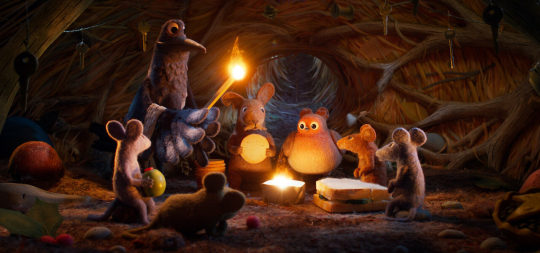

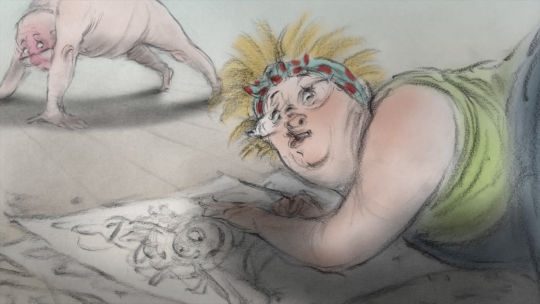


Best Animated Short Film Nominees for the 94th Academy Awards (2022, listed in order of appearance in the shorts package)
NOTE: Because moviegoing carries risks at this time, please remember to follow health and safety guidelines as outlined by your local, regional, and national health officials.
This blog, since 2013, has been the site of my write-ups to the Oscar-nominated short film packages – a personal tradition for myself and for this blog. This omnibus write-up goes with my thanks to the Regency South Coast Village in Santa Ana, California for providing all three Oscar-nominated short film packages. If you are in the United States and Canada, find which theaters are showing the Oscar-nominated short films here. Without further ado, here are the nominees for the Best Animated Short Film at this year’s Oscars. Films predominantly in a language other than English are listed with their nation(s) of origin.
As this is the tenth time I have seen the animated (and live-action) short film Oscar-nominated short film packages (since February 2012, missing 2014), I wanted to thank all those who have watched these films with me over the years – whether virtually, in-person, or in spirit. It has been my privilege to share these films with you.
Robin Robin (2021)
If the name Aardman Animations doesn’t ring a bell, perhaps their filmography does. The British stop-motion clay animation studio is responsible for the Wallace and Gromit and Shaun the Sheep films, in addition to standalone features such as Chicken Run (2000). Directed and co-written by Dan Ojari and Mikey Please (Sam Morrison is the third writer), Robin Robin is Aardman’s first foray into needlefelt stop-motion. Here, a family of mice adopts a baby robin (Bronte Carmichael), and they decide to raise her like a mouse (Adeel Akhtar voices Dad Mouse). Sometime later over Yuletide, the mice bring Robin along to their nighttime raid to help pilfer food from a “Who-Man” house. A mix-up brings Robin in the company of Magpie (Richard E. Grant), who has eyes set on a Christmas tree star to add to his collection, and a malicious cat (Gillian Anderson) looking for her next meal.
Robin Robin is a wholesome, if slight, delight for all of its brisk thirty-two minutes – deserving of becoming a family holiday tradition. As charming as the premise and execution are, the film contains some of the best animation in Aardman’s history. The animators sewed together at least five puppets of each major character, with a grand total of seventy-five puppets in use over eight months of filming. If, going into a first viewing of this film, one doubts that felt characters with googly eyes could be as expressive as any stop-motion character before them, be ready to have those expectations exceeded. So seamless are the characters’ movements that two people who I had the pleasure of seeing this with at first thought this film was computer-animated. The design and lighting of Robin Robin’s wintry wonderland – from the kitchens laden with food and the snowy exteriors – is immaculate, to the point where one almost forgets this is an animated short film. This is yet another stunning achievement from Aardman, befitting a studio that remains one of the standard-bearers for stop-motion animation.
My rating: 8.5/10
Boxballet (2021, Russia)
Kazakhstan-born director Anton Dyakov once taught children at an art school. During “free topic, free choice” time, he would notice that most of the boys would draw sportsmen (boxers, footballers) and the girls opted for dancers and ballerinas. As an inside joke to his friends, he would say that to make a film with a boxer and a ballerina would appeal to both. Many years later, those art school memories intertwine in the dialogue-free Boxballet, an allegorical film that waits until the last second to reveal its late Soviet-era underpinnings. It is 1991 in Soviet Russia. Evgeny is a boxer, bruised and bludgeoned over his many years in the ring. Olga is a ballerina who is facing pressure to return the invasive and unwanted affections of her ballet director so that she may play the title role in Adolphe Adam’s Giselle. Our two protagonists meet accidentally, and set off on an unlikely relationship from there.
The timing of Boxballet’s Oscar nomination during Russia’s full-scale invasion of Ukraine is a curious coincidence. When one realizes the film allegorizes the collapse of the Soviet Union, it is all the more curiouser. Olga’s ballet director and his behavior is a stand-in for the old Soviet state – its corruption, its obsolescence, its paper-thin strength. Her eventual decisions in the film are reflective of what democratic-minded Russians could envision for themselves in the early years of the pre-Putin Russian Federation. Evgeny and Olga, mulling their future together, also make their choices in light of the unpredictable chaos the future will later reveal. Elsewhere, the extreme contrast in the character designs strengthen the comedic elements of the film – physical (see the differences in boxer and ballerina movement) and romantic. Dyakov, working alongside for the first time with Melnitsa Animation Studio animators (2015’s We Can’t Live Without Cosmos), endows Boxballet with an intimacy that feels unexpected, but fully earned.
My rating: 7.5/10
Affairs of the Art (2021)
Most first-time viewers of Joanna Quinn’s Affairs of the Art might be surprised to learn that this is the latest film in a series. Quinn, best-known for creating the Charmin bears, has been telling the story of her anti-heroine, Beryl with Girls Night Out (1987), Body Beautiful (1990), Dreams & Desires: Family Ties (2006). In Affairs of the Art, we meet Beryl’s (Menna Trussler) family: husband Ifor, sister Beverly, and son Colin. Since viewers last met Beryl, she is now, “drinking through the cup of creativity” in using her body (and the reluctant Ifor) as an artistic subject. Her artistic instincts have consumed her – something that she compares to the obsessions of, through narrated flashbacks, Beverly (a taxidermist with a crush on Vladimir Lenin who yours truly believes is a psychopath) and Colin (anything of technical complexity). The disjointed structure and rambling narration are purposeful, as this latest nominee from the oft-nominated National Film Board of Canada (NFB) revels in its dark humor.
Is Affairs of the Art an unhinged ode to creating art or a spiel from a person who remains high-functioning despite a mental disorder? However one analyzes the film and whether or not you gel with its absurd and graphic comedy as written by Les Mills (Mills also wrote the previous Beryl-starring short films), Quinn’s movie is a stylistic wonder. Despite its rough pencil strokes to outline its characters and foregrounds, Quinn’s pencil animation keeps character animation unexpectedly fluid. The viewer can feel the weight of characters and intuit their gait in just a few seconds of screentime. For the first time in a short film starring Beryl, dialogue occurs on-screen. Quinn, who did not want to go through the trouble of syncing dialogue and animation, found that this process aided her film. The lip sync is an integral part of her characters’ acting. In conjunction with their designs, this provides Affairs of the Art a vitality that Quinn’s prior Beryl movies do not have.
My rating: 6.5/10
Bestia (2021, Chile)
Similar to the Academy Award-winning Bear Story six years ago, Bestia requires context for non-Chileans in order for them to fully appreciate the film. In 1973, a CIA-backed military coup d’état overthrew a democratically-elected socialist government. Its replacement was a junta headed by General Augusto Pinochet. With American assistance, Pinochet’s regime kidnapped, tortured, and executed political opponents through 1990 – several thousand desaparecidos (“disappeared”) remain unaccounted for. Hugo Covarrubias’ Bestia (“Beast”) follows a woman who resembles Íngrid Olderöck (“La mujer de los perros”), an infamous member of the Chilean secret police (DINA) who committed rapes and torture with a dog. The first half of Bestia follows our protagonist (“Íngrid”) as she goes about her silent, regimented morning routine with her canine companion. From the moment we meet Íngrid, the droning and unsettling score from Ángela Acuña immediately hints that what is about to occur will disturb the audience.
Bestia then spends the remainder of its time excavating the depths of Ingrid’s mentality – her casually violent thoughts and dreams, the callousness of her work, the mental detachment she adopts in order to be at terms with herself. If you have not seen this film and have read this far, you are probably imagining, accurately, the cinematic approach Bestia takes to show the calm in how Íngrid commits atrocities. As a stop-motion film, Bestia makes a key decision to represent its characters as porcelain dolls rather than clay or felt figures. Where most animated shorts wish to exaggerate character emotions and movements, Bestia distinguishes itself – and strengthens this personal portrait – by adopting the antithesis. As an inexpressive porcelain doll, Íngrid embodies the gruesome banality of her existence, never allowing the audience any tonal reprieve even in the closing seconds of the film.
Other writers, upon learning that Olderöck survived a 1981 assassination attempt, have bemoaned the she never received any punishment for her crimes in life. A little more than a week after viewing Bestia, I would not be so sure.
My rating: 8/10
The Windshield Wiper (2021)
The Windshield Wiper is a Spanish-American co-production directed by Alberto Mielgo. Mielgo has an eclectic visual résumé befitting the fascinating look of his newest film, including art direction on the television series Tron: Uprising, visual consultant on Spider-Man: Into the Spider-Verse (2018), and as director on an episode of Netflix’s Love, Death & Robots. As visually stunning as The Windshield Wiper is, its shapelessness is a detriment. The film begins with a lonely, cigarette-puffing man asking, “what is love?” For the remaining fifteen minutes of The Windshield Wiper, Mielgo presents various scenes of love – a couple lounging on a beach, two people at a grocery store oblivious to each other while swiping away on a Tinder-like app, a homeless man exclaiming how much he misses someone. These fragments, connected by the slenderest of threads, have little to offer about or on the opening question.
Appearing like an incompletely-rendered Spider-Man: Into the Spider-Verse, The Windshield Wiper’s stripped-down CGI animation is interesting to behold. At a time when CGI has unfortunately become the overwhelming default in American mainstream animation, The Windshield Wiper’s aesthetic serves as counterbalance. Mielgo appears that is he attempting a discourse on how modernity has filtered out genuine love, but the loosely-edited vignettes prevent much of the intended pathos. The film’s title, according to Mielgo, derives from the action of raindrops being cleared by a windshield wiper while driving. A pattern of rain appears differently each time, as does love. His film is approaching the avant garde, which – as Mielgo notes himself – will easily divide audiences in how they perceive his dense filmmaking.
My rating: 7/10
^ Based on my personal imdb rating. My interpretation of that ratings system can be found in the “Ratings system” page on my blog (as of July 1, 2020, tumblr is not permitting certain posts with links to appear on tag pages, so I cannot provide the URL).
From previous years: 85th Academy Awards (2013), 87th (2015), 88th (2016), 89th (2017), 90th (2018), 91st (2019), 92nd (2020), and 93rd (2021).
For more of my reviews tagged “My Movie Odyssey”, check out the tag of the same name on my blog.
#Robin Robin#Boxballet#Affairs of the Art#Bestia#The Windshield Wiper#Dan Ojari#Mikey Please#Anton Dyakov#Joanna Quinn#Hugo Covarrubias#Alberto Mielgo#Aardman#Netflix#94th Academy Awards#Oscars#My Movie Odyssey
32 notes
·
View notes
Photo

Festive Picture Books for Christmas by Black Authors
Recently chef and author Carla Hall appeared on a talk show to discuss her new holiday picture book Carla and the Christmas Cornbread. She shares that while working on her memoir, “we took one of the chapters from my childhood and turned it into a children’s book.” Hall’s book was released this month and is described as a “heartwarming tale.” It is so exciting that five of the books on the list were all published this year, in 2021. Christmas is always about sharing traditions, which sometimes means reading favorite stories. Hopefully, the new Christmas stories featured can create new memories and traditions.
Charlotte and the Nutcracker: The True Story of a Girl Who Made Ballet History
Charlotte Nebres
Alea Marley
Random House BYR (2021)
Santa in the City
Tiffany D. Jackson
Reggie Brown
Dial Books (2021)
Carla and the Christmas Cornbread
Carla Hall
Chelsea Harris
Denene Millner/S &S BYR (2021)
The Real Santa
Nancy Redd
Charnelle Pinkney Barlow
Random House BYR (2021)
The Perfect Gift: A Jingle Jangle Story
Lyn Sisson-Talbert
David E. Talbert
Razorbill (2021)
The Square Root of Possible: A Jingle Jangle Story
Lyn Sisson-Talbert
David E. Talbert
Razorbill (2020)
Go HERE to see more titles!
Follow💻Subscribe: Twitter | Instagram | Facebook | Newsletter
84 notes
·
View notes
Text
Rainbow Sheeps Artober 2021
Hey folks! This is year 2 of Rainbow Sheeps Artober! This year we had five themes, Dragons, Myths, Holidays, Fall Food and Cozy Clothes. There are 155 prompts, five a day, for you to choose from! You can participate using any medium you want, writing, painting, digital art, cross stitch, etc - Mods Kili (@bat-kili) and Grey (@pokemontrainerfromgallifrey)
Flight Atop a dragon, favorite being from Mythos, Santa Claus’s Halloween Party, Pumpkitten Spice Latte, Cloak
Raising a baby dragon, Zeus failing to seduce something, an Addams Family Christmas, Packed Lunches, Fluffy Pajamas
A dragon who’s hoard is stuffed animals, Icarus and his boyfriend Apollo, Holidays as people, latte art, scarf worn by an animal
Autistic Dragon, Zeus taking all his kids to the mall for halloween costumes, Misadventures of Holiday decorating, Ginger Snaps, blanket cocoon
Tiny dragon who’s hoard is a single coin, Zeus messes up again, Santa Claws, Cinnamon Rolls, OC in a fluffy jacket
Dragon Dance, Arachne, Sp00ky Scary Skeletons, Your favorite fall dish, Comfy Movie Night
Baby Dragons in Halloween Costumes, Your favorite LGBT+ Myth, Holiday traditions, carving pumpkins to make pumpkin pie, new boots
Dragon family tree, hunters of Artemis Sleepover, Picking the Tree, Corn ¯\_(ツ)_/¯, Rain Boots
Dragons based off of an animal different than reptiles, Misunderstood Medusa, all the spirits of holidays together for new years eve, pumpkin spice prank potion, fluffy beanie
A herd of Dragons, Selkie Selkie Selkie Selkie, Menorah, Serving the Community, Sweater Weather
Feathered Dragon, A modern Myth of Gemini, Aliens First (Christmas, Kwanzaa or Hanukkah), A mug of your favorite fall drink, Oversized Sweaters
Dragon Halloween Party, your favorite myth but modern day, make up a new holiday and describe it, Corn Maze, birdies in a beanie
Hiding a dragon in your basement, Thor’s wedding to Thrym, I really don’t hate Christmas, Fancy Hot Cocoa, favorite sweater/hoodie
Ugly Duckling but Dragon, Hades and Persophone, Travel, Fall cafe, Snow suit and sledding
Jake Long, The aftermath of a great Mythological War, Pumpkin Carving, Pumpkin Spice Sweets, New Hat
Befriending the allegedly evil dragon, Your favorite myth but with furries, Holiday family dinner/ dinner with friends (or for Halloween just eating all the candy with a lack-there-of), Cupcakes with Candy corn, Fall themed socks
Dragons taking their kids trick or treating, if you were a Greek god what would you be the god of?, Holiday meals, Apple Cider, Blanket fort
Fire breathing bearded dragon, Gorgon sister braid train, Kwanzaa Celebration, Pumpkin Spice Drama, Warm gloves
Damsel in distress is secretly the dragon, Minotaur, Halloween, Apple Picking, newly made Crochet clothes
Yourself in Dragon Form, Griffin/Chimera, Halloween Monsters Holiday Party, Pumpkin Pie, Pajama Party
Dragon playing in a pile of leaves, Create your own Mythos, national start of Pumpkin Spice Day, Popcorn, Clothes throughout History to keep people warm
Dragons but in modern day jobs, Dryad and Naiad meeting, Ghosts at halloween, peppermint mocha, legend of the travelling hoodie
Unusual Dragon Hoards, Angel, Christmas Shopping, An assortment of pumpkin flavoured pastries in bakery window, warm woolen socks
A dragon craftsmen, Thor attempts to drink the ocean, retail workers during the holiday season, Thanksgiving Prep Work, Clothes Shopping for warmer clothes
Dragons of different elements, Pantheons trick or treating at other Pantheon’s houses, Valentine’s with friends, Food Falling, Baby Blanket
A dragon’s protection, A trans dryad or satyr, what’s left after a holiday party, Pumpkin Spice Everything, Dressed for Apple Picking
Dragon shapeshifter, Two gods from different pantheons who have fallen in love, Trick or Threat, Freshly baked goods, Knitted Clothing
Nesting Dragons, Fave Pantheon Trick or Treating, Thanksgiving w/ your favorite video game character, hot chocolate, DnD in Costume
A dragon terrorizes a town every October, A phoenix perched on the shoulder, A feast, Pumpkin Soup, huddled up looking at snowfall
A dragon peacefully in the forest, Satyrs, Holiday Shopping (not christmas), Halloween Candy, Favorite Fall Outfit
Winning a dragon’s trust, A halloween party where everyone is dressed as someone from Mythology, Found family thanksgiving, Caramel Apples, Dressing up for the first day of school
47 notes
·
View notes
Photo




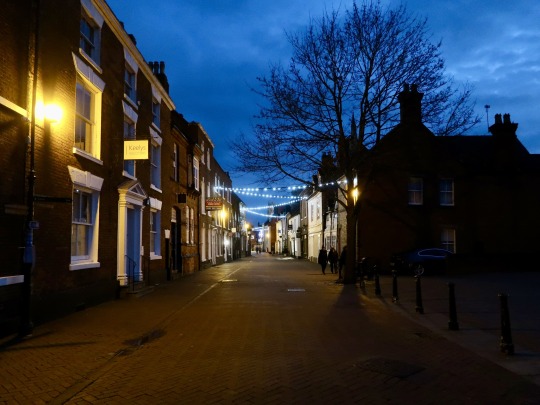




#365daysofbiking The thinness of the air, and turning for home:
31st December 2021 - It’s been a weird old Christmas. The weather has been the worst over the holiday period I’ve known in many years: Pretty much constant rain and drizzle for over a week.
The festive period is normally an opportunity for us to get out on some seriously nice rides - often in the lead up to Christmas, the traditional Christmas and Boxing Day rides, and there’s usually good fun to be had in the period up to and including new year.
But not this time. The ceaseless downpour has meant that although I’ve been cycling every day, it’s been for utility only; delivering presents or cards, seeing friends and relatives, going to the pub, getting shopping in or getting fresh air.
Every journey has been in waterproofs, and I’ve come back sodden. It’s not been nice.
But on New Year’s Eve, a day I usually hate, the rain stopped. The sun came out. But odder than that, it was warm. And I mean, really warm: 14 degrees. It was like spring out there.
I set off later than I’d planned with my young pal for a loop around the local area, as we had an errand to do in Lichfield, and another in Burntwood.
The riding was fast and easy: There was a strong wind, but frankly, it didn’t matter. Up over Stonnall, Thornes, and the backlanes into Shenstone - but as we neared the village on the hill, we realised something was different. The old, ruined thirteenth century church tower - a remnant of an older, nicer church before the gothic horror that stands today was born of Victorian hubris - was sheathed in plastic sheeting and scaffold. It seems to be undergoing renovation. This is interesting, as it’s been derelict for all of the 40 or more years I’ve been riding around here.
It seems that a group have got together, raised money and are renovating the tower to save it out of charity and community spirit. Yet again, communities pay for Church of England neglect, it seems. But the plan is good and seemingly very competent. Searching when we got home we found the tower has a website here which is pretty useful on history, but not on the future. For that, we found Lichfield Live had reported plans to add a viewing platform to the tower last March. To my surprise, these have been approved.
I do hope this will be open to the public periodically. I bet the view is incredible. I salute those undertaking this project - it’s remarkable. This has largely passed me by over the summer and is an indication of my failure to ride much that ways on last year. I must rectify the neglect.
Further on, we caught a fair sunset up at Chesterfield, between Shenstone and Wall - any sunset is a bonus right now. Pickle caught it well, as she did a somnambulant, subdued Lichfield. The bars seemed busy but the streets less so. As ever, the festive lights and night sky combined with the muted, orange street lighting to make a magic that Pickle was all too keen to capture.
Returning down the wonderful Chasetown High Street, Pickle noted that the Christmas lights were switched off, but it didn't matter, as it’s always festive at night on the beautifully lit, inclined High Street. I don’t really know what it is about Chasetown, but it shares the phenomena with Walsall Wood. At night, it always seems much busier than it actually is, and has a lovely homely, soft glow to it.
As New Year’s Eve rides go, this has been the best for a few years. We both enjoyed the absence of rain, and the thin, clear air. Such a change from the last couple of weeks... But as we stood at Chasewater, with nothing but the sound of water lapping against the dam, we reflected on the year gone. It’s been hard. There have been times when I wondered if I’d ever do another long ride again. But there has also been great joy: Recovery, the longed for autumn long rides, the return to the outdoors, the sharing of moments like this.
So we turned for home feeling positive, and light with the optimism of a new riding year ahead. There will be winter yet, yes - but spring and the daffodils and cowslips. Long rides on the Moorlands and Peaks. Green on the trees and hedgerows. Summer days and cafe stops and ice cream, and even the odd pub garden. It’s all to come. It was impossible not to face the prospect with an open, happy heart.
Happy new year to you all.
Thank you too for all of your messages of support and encouragement over the last week. Dry Valleys summed it up when he said you cannot serve from an empty vessel. For a while, I was empty. But now... I am feeling somewhat replenished.
Thank you to the wonderful community that support me here.
This journal is also on Wordpress, where the pictures are in higher resolution and the search box works! Click here.
#365daysofbiking#Shenstone#tower#restoration#interesting architecture#Chesterfiueld#sunset#Lichfield#Night phtography#chasetown#Chasewater#new year#optimism#pickle
5 notes
·
View notes
Text
Spencer (2021)

If you still think of Kristen Stewart as that bad actress from the Twilight films, you won’t even recognize her in Spencer. She gives a stunning performance in a film full of complicated emotions.
Inspired by real people, this fictional tale begins on December 24th, 1992. Diana, Princess of Wales (Stewart) upsets the British royal family by arriving at the Queen’s Sandringham Estate alone. As she attempts to abide by the exhausting Christmas traditions imposed upon her by the family’s long history, she struggles with her mental state and uncertain future.
All little girls dream of becoming princesses. Many films have shown us that being a big deal isn’t what you dream it is but none quite like this. Diana’s husband, Prince Charles (Jack Farthing) is having an affair. Going through a marital crisis on a normal day would be difficult but Diana's circumstances make it particularly hard. Ideally, Christmas is a joyous occasion whose sanctity shouldn't be spoiled by bad news but there’s no joy here. This holiday in Norfolk is cold and uncaring. It’s all about what outfits you’re scheduled to wear, how little of a fuss you can make, how few pictures the paparazzi snap of you. The royal family pretend like they aren’t people; like they just happen to live among. Diana knows first-hand that princes aren’t inherently wonderful, that "royal" means nothing.
The extent of the family's self-importance and cruelty is illustrated via the giant portrait of King Henry VIII hung up like he's the patron saint of happy marriages. Henry VIII grew tired of his second wife and had her executed. Everyone knows that, but he's still up there. As such, Diana feels a kinship with Anne Boleyn (Amy Manson), whose “ghost” "haunts" the building. What happens to her if she tries to leave the family?
With few opportunities to confide in anyone, Diana has few ways to express the unhappiness she feels out loud. This is where Kristen Stewart’s performance comes in. She’s so good at communicating the uncertainty, stress, sadness, outrage, dissatisfaction, and despair Diana feels. Then, there are these little scenes where we get to see her smile. The "Diana, Princess of Wales" disappears and the "Diana Spencer" comes back. The moments of joy with her children (played by Jack Nielen and Freddie Spry) are particularly emotional. Diana knows what it’s like to grow up normal. Her children do not. Her past, their future, the uncertainty of her marriage, her place in the royal family are all converging. It feels like it’s too much to handle. She imagines what it would be like to just quit everything. If you didn’t “get” why Prince Harry (The real person) decided to step away from the royal family, why the idea of kings and queens is out of date in 2021, this film shows you.
Spencer isn’t satisfied with a traditional exploration of its protagonist. Director Pablo Larrain uses dreams/hallucinations and quiet shots to show us what the character feels rather than spell it out. It’s a good thing Kristen Stewart (who is sure to get all sorts of nominations and awards) is up to the task. For her alone, the film is worth seeing. (Theatrical version on the big screen, November 6, 2021)

#Spencer#movies#films#MovieReviews#FilmReviews#PabloLarrain#StevenKnight#KristenStewart#TimothySpall#JackFarthing#Seanharris#SallyHawkins#2021 movies#2021 films#PrincessDiana
4 notes
·
View notes